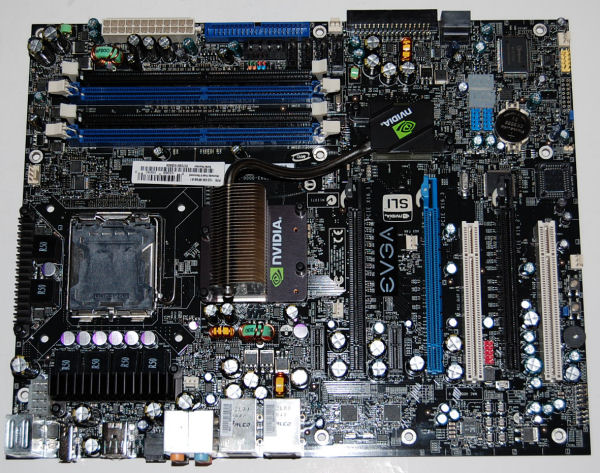First, we were extremely curious why the NVIDIA 680i based motherboard which 60 days ago was the “holy grail” of overclocking lost so much popularity in the enthusiast ranks, seemingly overnight. Secondly, we were curious to see if the 680i as advertised truly supported the new 1333MHz standard and if so how it performed in a head-to-head comparison against the P35. For the record, this is an article for informational puposes and not a review thus we will refrain from scoring any products being tested.
INTRODUCTION
For the last month or so the hot discussion in the computer enthusiast community has centered around motherboards based on the Intel P35/ICH9R chipset. The hype for these products has been nothing short of phenomenal. In discussions that we’ve read on various enthusiast forums a few of the many primary reasons we could ascertain for this fervor were: (Note: We paraphrased for brevity’s sake.)
- The P35 supports the 1333MHz version Core 2 Duo processor
- The P35 has better support for the current quad processors in the Core 2 Duo lineup
- The P35 has support out of the box for the forthcoming Intel 45nm dual-core Wolfdale and the quad-core Yorkfield processors
- The P35 uses Intel based components as opposed to those offered by NVidia
- The P35 is faster and easier to overclock
- Some manufacturers are making P35s which support DDR3
- The P35 is more stable than the other options that are available
- The P35 is a great board and it would be perfect if it only supported SLI …
- I’m off for the next few days and need a new project, so I bought a P35
We’re certainly not going to try to either support or dispute any of the rationale used by our enthusiast brethren in making these statements. In our own testing we have found the P35 boards to be quite capable. We’re also well aware that the release of any new product coupled with the marketing hype that surrounds it can readily turn today’s hot property into yesterday’s news. All of us that adorn the enthusiast title are guilty of wanting and in many cases getting the latest and greatest as soon as possible after the product hits the market.
If everything you’ve said thus far is true then why even bother to bring all of this up? Good question! First, we were extremely curious why the NVIDIA 680i based motherboard which 60 days ago was the “holy grail” of overclocking lost so much popularity in the enthusiast ranks, seemingly overnight. Secondly, we were curious to see if the 680i as advertised truly supported the new 1333MHz standard and if so how it performed in a head-to-head comparison against the P35. For the record, this is an article for informational puposes and not a review thus we will refrain from scoring any products being tested.
THE COMPETITORS
Before jumping into the testing phase we thought a picture of each of the competitors would be appropriate especially for those that have never used one or all of the board being tested. All of the products tested with the exception of the Gigabyte P35-DQ6 have been reviewed by Bjorn3D, we will link to those reviews in case you need further information concerning features, specifications, or other relevant information not contained in this article.
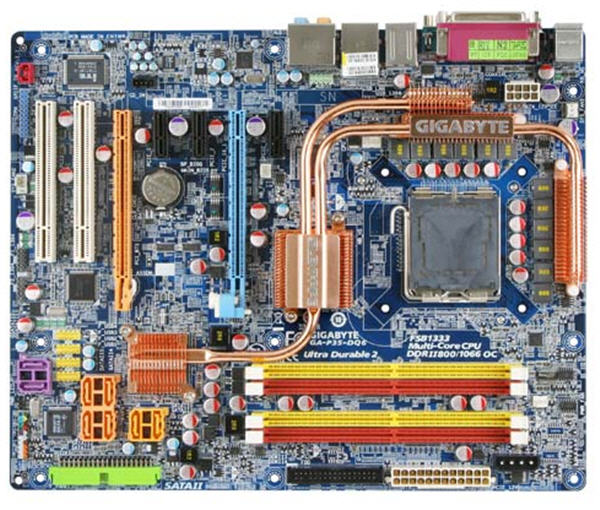
Gigabyte P35-DQ6 Motherboard
TESTING
As previously stated the test results of these boards are for our readers to use as comparison purposes. We used our standard motherboard testing regime in testing each of the products. All of the tests were run utilizing an Intel Core 2 Duo E6850 processor at 1333MHz to dispel any myths about any of these boards ability to support that standard.
|
Test Platform |
|
|
Processor |
Intel E6850 Core 2 Duo at 3.0GHz … 1333MHz |
|
Motherboard |
Test Board #1: ASUS Blitz Formula SE BIOS 0903 |
|
Memory |
2GB of OCZ Reaper 8500 DDR-2 @ 1067MHz, 5-5-5-15 2.2V |
|
Drive(s) |
2 – Seagate 750GB Barracuda ES SATA Drives |
|
Graphics |
XFX GeForce® 8800 GTX XXX running ForceWare 162.22 |
|
Cooling |
Enzotech Ultra w/ 120mm Delta Fan |
|
Power Supply |
PC Power & Cooling 1KWSR PSU |
|
Display |
Dell 2407 FPW |
|
Case |
Lian Li G70 (highly customized) |
|
Operating System |
Windows Vista Ultimate 32-bit |
Unfortunately when testing a motherboard there is not set of “grass roots” tests that will speak to the motherboard’s overall performance. It is therefore necessary to comparatively test the performance of the CPU, Memory, Hard Drive(s) and Graphical Rendering and then you can make assumptions from the results of these tests.
|
Synthetic Benchmarks |
|
PCMark 05 v. 1.2.0 |
|
3DMark06 v. 1.1.0 |
|
SiSoft SANDRA XI Professional |
|
Cinebench 9.5 (Daylight) |
|
SuperPi Mod 1.5XS |
|
HD Tach RW 3.0.1.0 |
|
Games |
|
S.T.A.L.K.E.R. v 1.30 |
|
Company of Heroes DX10 |
|
Lost Planet DX10 |
We will test each of these boards using purely stock settings utilizing the benchmarks and games captioned in the table above. Overclocking will be addressed later in this review.
TEST RESULTS
CPU
Although “synthetic benchmarks” aren’t the complete answer when testing products as long as the testing is done using the same uniform procedure(s) and settings each time they are run should yield a fairly reliable idea of the product’s performance. We chose SANDRA XI SP2 Professional, Everest Ultimate Edition 4.00.976, PCMark05’s entire CPU suite, and Cinebench 9.5 one and multiple CPU rendering tests to relate CPU performance. Each was run three times with an average of the results being used to report in this review. .
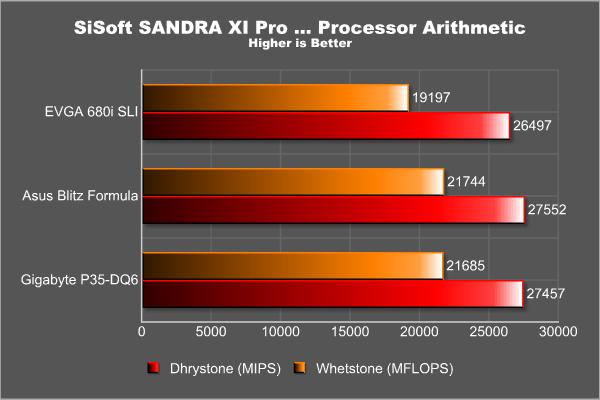
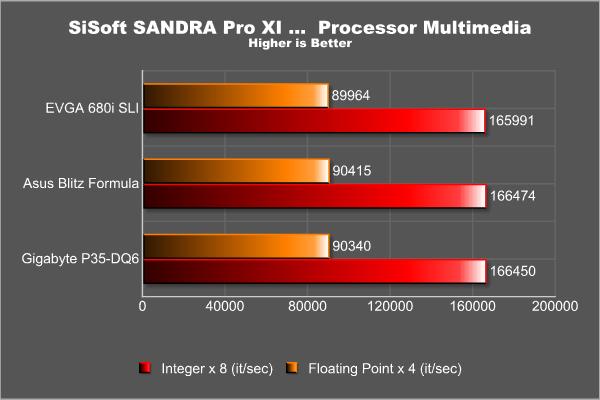
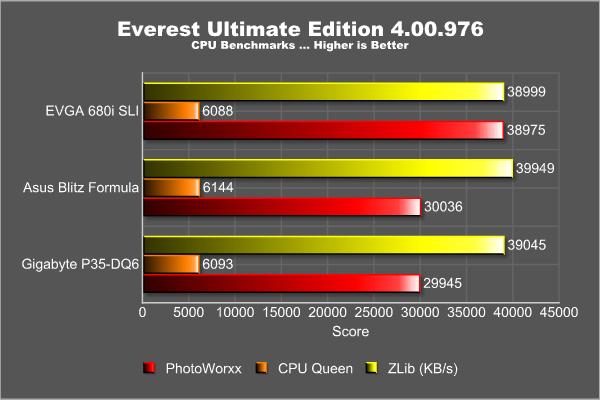
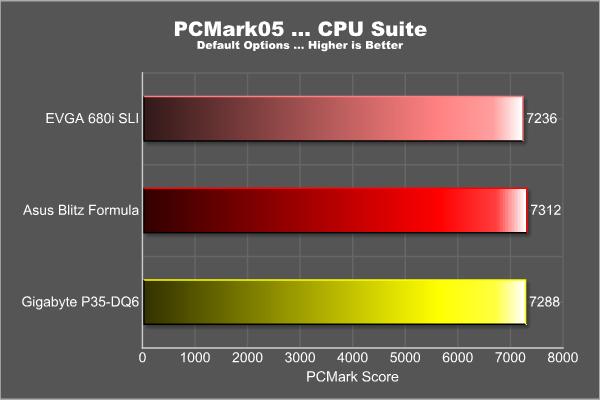
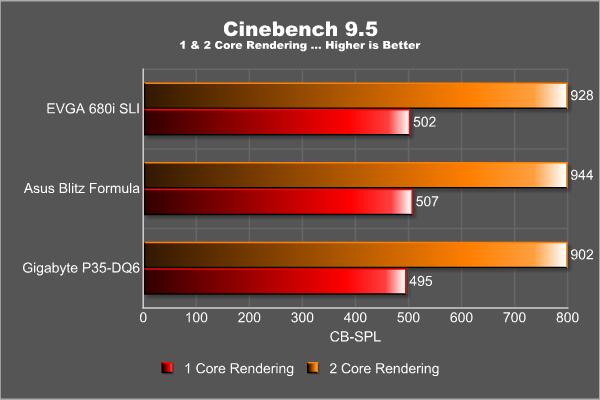
TEST RESULTS
Memory
Again we turned to the same trio of synthetic benchmarks to relate the performance of the memory with these two boards. With PCMark05 we ran the entire suite of memory tests that it offers. Remember we are using a 2GB kit of OCZ Reaper 8500 Memory for our performance testing which is running on all of these trials at 1066MHz and timings of 5-5-5-12 at 2.2 volts when utilizing the results for any comparisons that you may make between this review and others you may read. We utilized the same procedure for running the benchmarks as we did in the CPU performance testing.

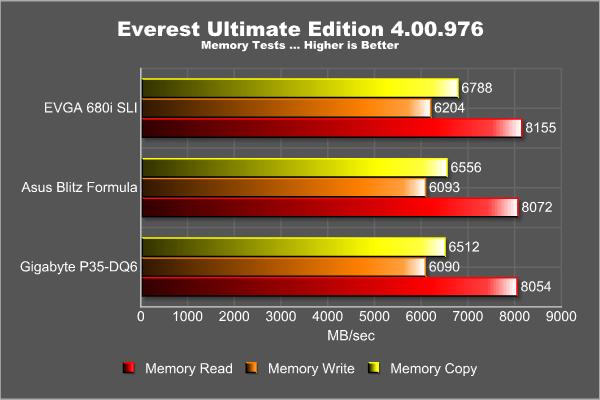

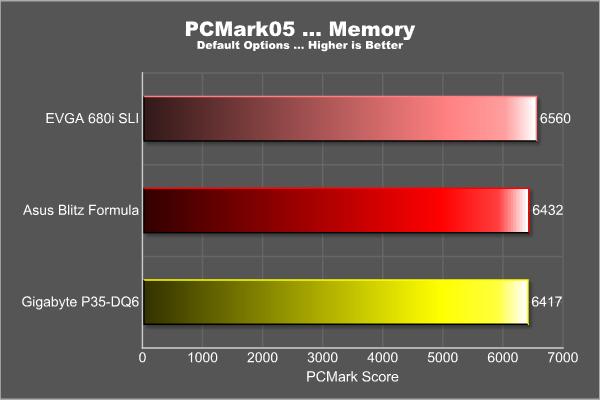
TEST RESULTS
Storage
In addition to utilizing PCMark’s HD entire suite of tests we opted to add an additional benchmark which is well known to the computer enthusiast, HD Tach RW 3.0.1.0. In addition to testing the Seagate Barracuda 750GB ES drive we added a small AVB 4GB USB Flash Drive to the component test results in HD Tach to affirm the USB capabilities of these two boards. We displayed the HD Tach results in table form as opposed to having separate graphs for each of the four test results that were rendered as we feel it provides better visual comparison.
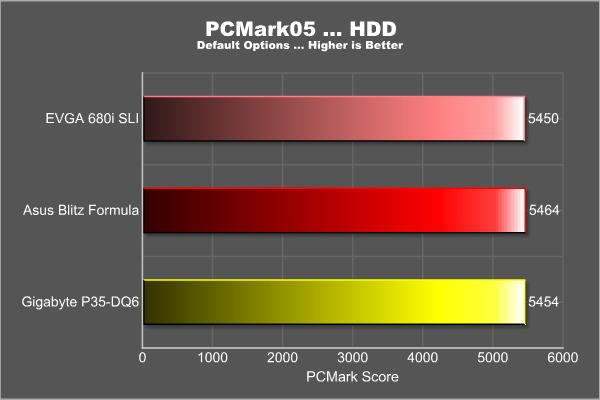
|
Seagate 750GB Performance … HDT-RW 3.0.1.0 |
|||
|
ASUS Blitz Formula |
EVGA 680i SLI |
Gigabyte P35-DQ6 |
|
|
Random Access Time* (ms) |
14.1 |
14.2 |
14.3 |
|
Average Read Time (MB/sec) |
66.1 |
66 |
66 |
|
CPU Utilization* |
1% |
1% |
1% |
|
Burst Speed (MB/sec) |
255.1 |
254.9 |
254.3 |
|
*Lower is Better … Otherwise Higher is Better |
|||
|
AVB 4GB USB Flash Drive … HDT-RW 3.0.1.0 |
|||
|
ASUS Blitz Formula |
EVGA 680i SLI |
Gigabyte P35-DQ6 |
|
|
Random Access Time* (ms) |
14.2 |
14.3 |
14.3 |
|
Average Read Time (MB/sec) |
30 |
30 |
29.8 |
|
Average Write Time (MB/sec) |
24.2 |
24.0 |
24.1 |
|
CPU Utilization* |
5% |
7% |
6% |
|
Burst Speed (MB/sec) |
31 |
39 |
30 |
|
*Lower is Better … Otherwise Higher is Better |
|||
System Performance
We thought this would be a perfect time to run a “real life” test that truly measures system performance as a whole excluding the drives. We opted for SuperPi which is the “Gold standard” for many enthusiasts when it comes to judging system performance. We ran 1 and 2 Meg calculations again running each test five times and threw out the two highest and the two lowest reporting the single remaining result.

Graphics & Gaming
While graphics are of paramount importance to the computer enthusiast they serve little use in testing a motherboard other than for validation purposes. What we mean is that many of today’s graphical benchmarks rely more heavily upon the GPU/VPU in the graphics card than they do upon the rest of the system resources for favorable results. This is a dual edged sword in that consumers with lesser grade CPUs, motherboards and memory may in some cases still have a favorable improvement in their graphics and gaming experience simply by adding an enhanced video card to their mix of components. 3DMark 2006 was also run at its standard default settings. We ran all games at a resolution of 1280 x 1024. No Antialiasing or Anisotropic Filtering was used to take the GPU out of the mix as much as possible. Oh, and for grins and giggles we ran two of the games in DX10 mode.
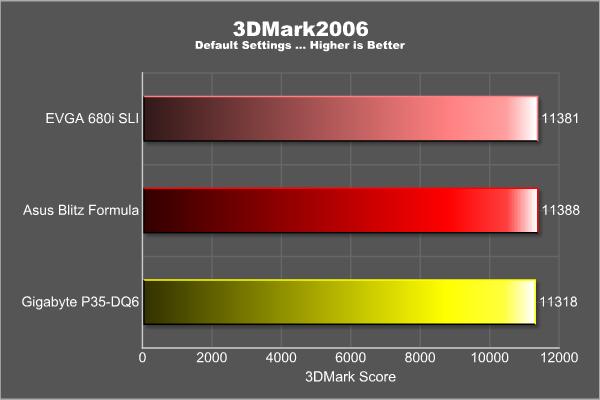
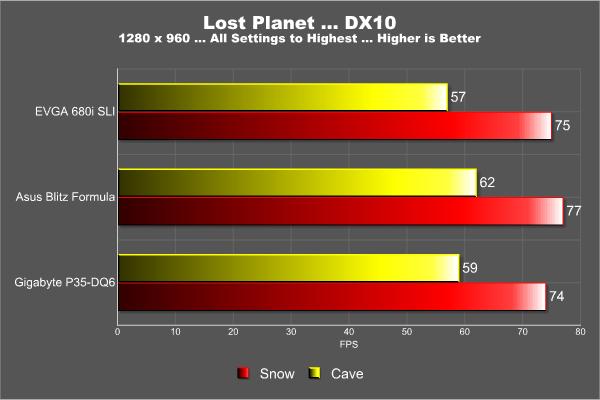
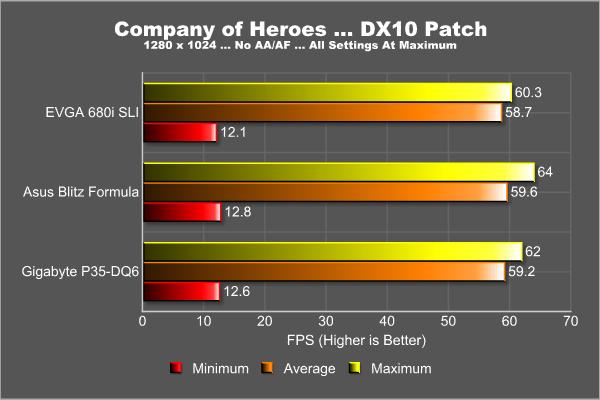
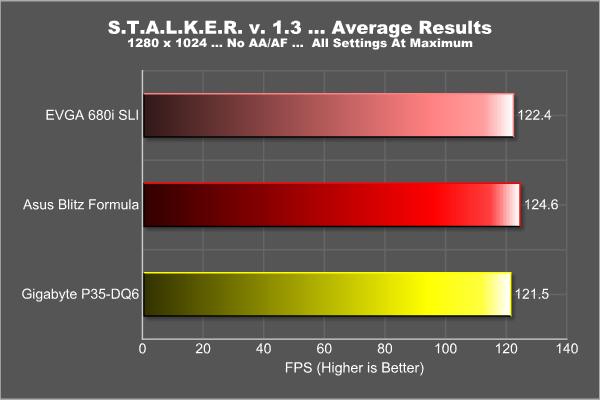
OVERCLOCKING
We took a slightly different approach to overclocking with this review. After reading so many excellent reports on the Intel Core 2 Duo E6850’s overclockabilty we decided to see just how high we could push this baby without changing the multiplier. The Asus Blitz Formula was the better overclocker between the two P35 boards; so we pitted it against the EVGA 680i. Surprisingly enough both boards overclocked identically using the the criteria we just alluded to. The EVGA 680i SLI was however able to run its memory settings at almost 180MHz higher clock speed.
Asus Blitz Formula
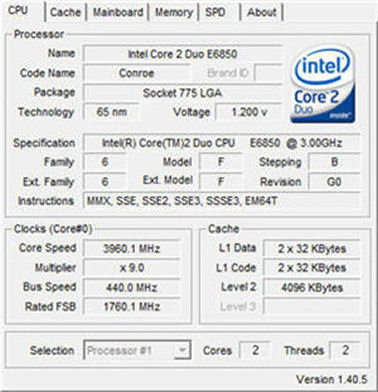
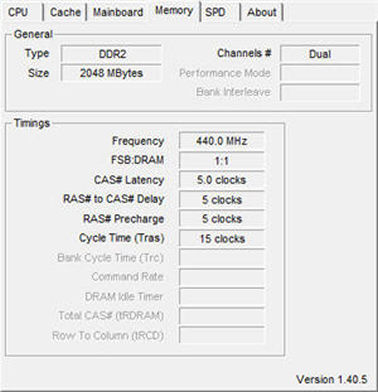
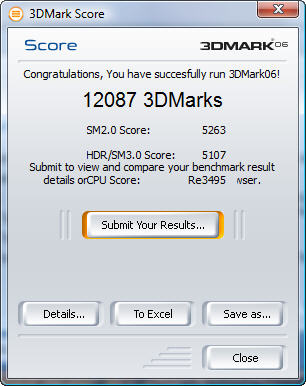
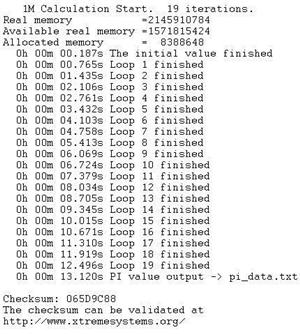
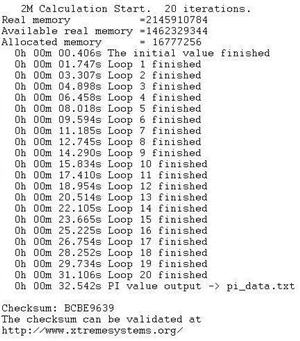
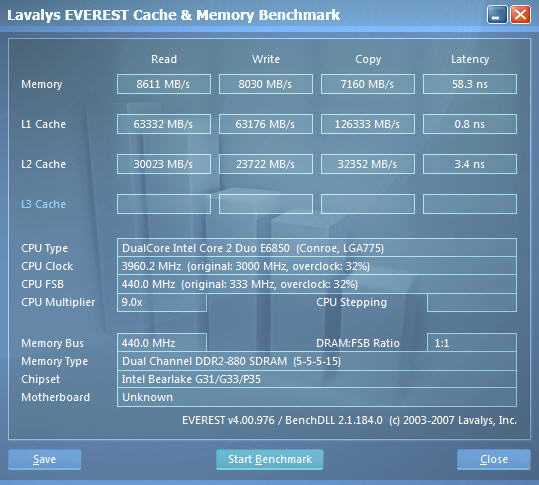
EVGA 680i SLI
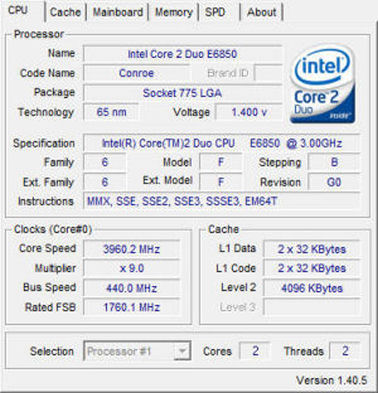

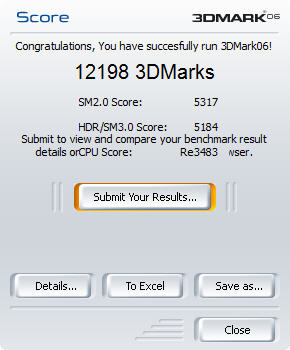
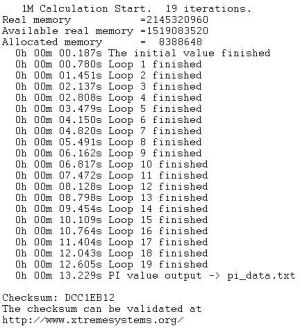
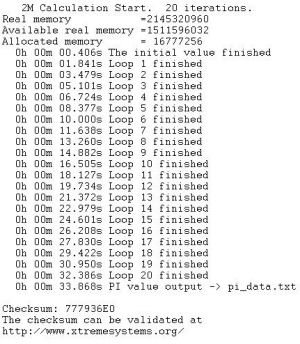
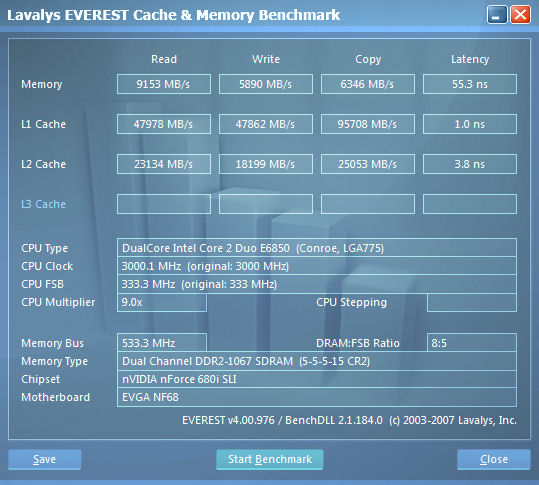
CONCLUSION
Now that the testing is done it’s time to make a few assumptions based on the results:
- The P35 is slightly superior in CPU performance @ 1333MHZ
- The 680i is vastly superior in Memory performance @ 1333MHZ
- The P35 is slightly superior in System Performance @1333MHz
- Storage performance, graphical performance, and overclocking are all either a wash or too close to call
It goes without saying that we were unable to test either the P35 or 680i’s ability to support the forthcoming Intel 45nm dual-core Wolfdale and the quad-core Yorkfield processors. Each of the chipset manufacturers for the boards claim that the Penryn series of processors will be fully supported be it by updating the BIOS or by other means. Computer enthusiasts are by nature somewhat skeptical as they have heard these type of promises before only to be completely disappointed. With this in mind all we can do is wait and see.
If you are thinking of purchasing a board with one of these chipsets or for that matter you have already purchased one there is another issue that you should probably be aware of. Does the motherboard support the new PCI Express 2.0 graphics cards that are just around the corner? For that matter will the reputed downward compatibility of PCI Express 2.0 function on your current motherboard when running these soon to be cards in either SLI® or CrossFire™ modes? This issue was recently discussed in a short article at X-Bit Labs and was called to my attention by one of my colleagues at Bjorn3D.
The title of this article as the question: 1333MHz … Who are the Big Dogs? It is quite evident to me after doing the testing and working extensively with each of these boards that both the P35 and 680i are both big dogs, each is a very big dog in their own right!
 Bjorn3D.com Bjorn3d.com – Satisfying Your Daily Tech Cravings Since 1996
Bjorn3D.com Bjorn3d.com – Satisfying Your Daily Tech Cravings Since 1996

